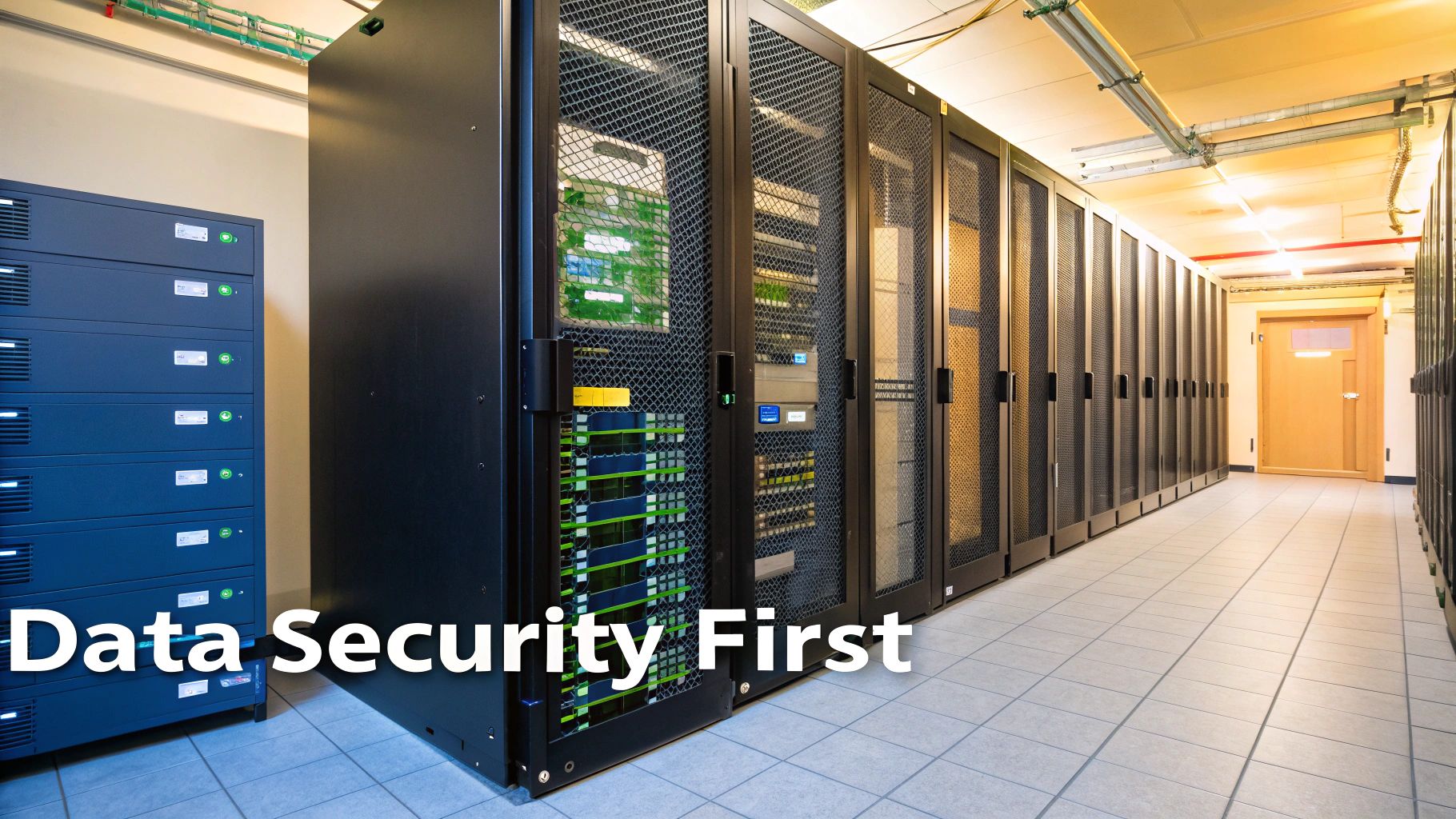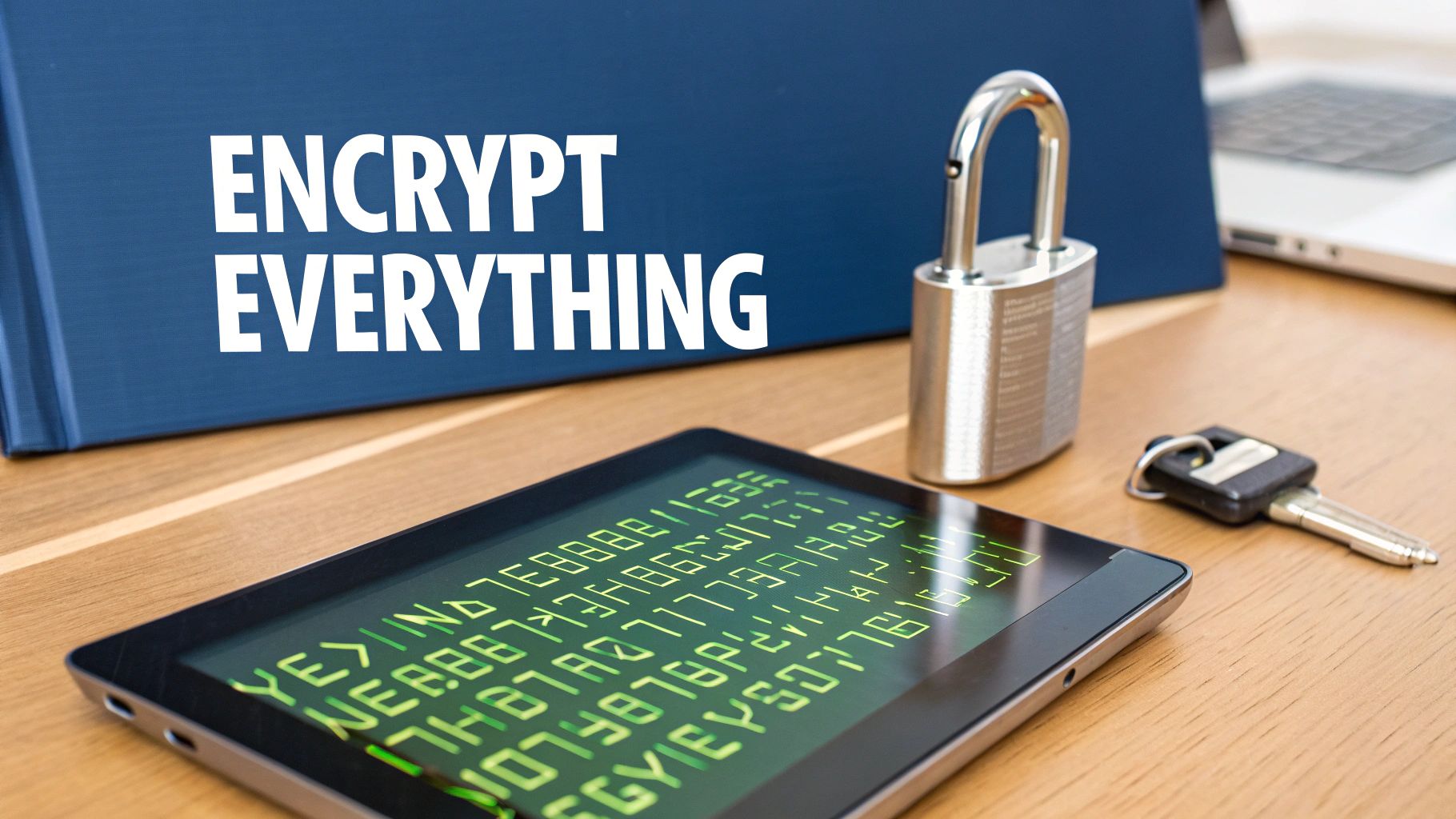Data Encryption Best Practices: The Complete Guide to Building Bulletproof Security
Understanding Modern Data Encryption Fundamentals

Think of data encryption as a digital safe - it converts readable information into scrambled code that only authorized people can access. The process relies on mathematical formulas and special keys to protect sensitive data. Getting encryption right is essential for keeping digital information secure.
Core Concepts in Data Encryption
There are two main ways to encrypt data. Symmetric encryption uses a single key to both lock and unlock data, like using the same key for your front door. While this method is fast, sharing the key securely can be tricky. Asymmetric encryption uses two different keys - a public one to encrypt and a private one to decrypt. This makes sharing keys easier but takes more computing power.
The methods we use to encrypt data have evolved over time. Early approaches like DES used short 56-bit keys and worked with small chunks of data. While DES was groundbreaking when introduced, it's no longer secure enough for today's needs. Learn more about encryption algorithms. This history shows why we must keep improving our encryption as technology advances.
Choosing the Right Encryption Algorithm
Picking the right encryption method depends on what you need to protect and how fast it needs to work. For symmetric encryption, AES and Triple DES are popular choices that offer strong security. When it comes to asymmetric encryption, many organizations rely on RSA and ECC to exchange keys and create digital signatures. Before selecting an algorithm, carefully consider your security needs and performance requirements.
Implementing Effective Data Encryption Best Practices
Good encryption involves more than just picking an algorithm. Here are key practices to follow:
- Key Management: Create, store, and update encryption keys securely using proper key management systems
- Protect Data Everywhere: Encrypt information both when it's stored and when it's being sent over networks
- Multiple Security Layers: Combine encryption with other security tools like access controls, multi-factor authentication, and monitoring systems
Following these practices creates strong data protection. Remember that security needs constant attention - regularly review and update your encryption approach as new threats emerge. This helps ensure your sensitive data stays protected over time.
Mastering Key Management for Maximum Security

Strong encryption is only as good as the keys used to control it. With cyber threats on the rise, managing encryption keys properly has become essential for protecting sensitive data. This includes everything from generating random keys to storing them securely and rotating them regularly. Learn more about encryption best practices.
Generating Strong Encryption Keys
The first step in key management is creating truly random, unpredictable keys. Using cryptographically secure random number generators is essential - think of it like creating an unguessable password. Simple patterns are easy to crack, while truly random combinations provide much stronger security.
Secure Key Storage Solutions
Keys need robust protection once created. Most organizations use specialized Hardware Security Modules (HSMs) or Key Management Systems (KMS) to safeguard their keys. These systems work like high-tech vaults, protecting keys from theft and tampering through multiple security layers.
Implementing Key Rotation Strategies
Regular key rotation helps limit potential damage if keys are compromised. Just as you should change important passwords periodically, encryption keys need updating on a set schedule. This ensures that even if attackers obtain an old key, they can't use it to access current data.
Best Practices for Key Management
For the strongest security, follow these key management guidelines:
- Establish a clear key hierarchy: Create a structured system with master keys protecting lower-level keys
- Implement strong access controls: Only grant key access to those who absolutely need it
- Develop a robust key recovery plan: Create secure backup procedures for lost or compromised keys
- Regularly audit key management: Check compliance and identify potential issues through periodic reviews
Following these practices helps organizations build a solid key management program that protects sensitive data effectively. Regular assessment and updates ensure the system stays strong as security needs change over time.
Building Multi-Layer Security That Actually Works

Think of data encryption like a sturdy lock on your front door - while essential, it works best when combined with other security measures like alarms, sensors, and vigilant monitoring. This multi-layered strategy, known as defense-in-depth, is how leading organizations protect their sensitive data effectively.
Integrating Encryption With Other Security Measures
Strong encryption needs to work seamlessly with complementary security tools. Access controls limit who can view sensitive information, ensuring that even if someone breaches the encryption, they still can't access the data without proper authorization. Multi-factor authentication (MFA) adds another critical layer by requiring multiple forms of verification before granting access. The adoption of MFA has seen significant growth, increasing from 57% to 69% among businesses in 2020. Learn more about current security trends here: Data Security Statistics
Monitoring and Incident Response
Real-time monitoring is crucial for catching potential threats early. Monitoring tools continuously scan for suspicious activities and alert security teams immediately when they detect unusual patterns. Having a clear incident response plan is equally important - this outlines specific steps for containing breaches, recovering data, and preventing future incidents. Regular testing and updates to this plan help ensure your team can respond quickly and effectively when issues arise.
Overcoming Integration Challenges
Getting different security systems to work together smoothly can be tricky. Systems may have compatibility issues or create bottlenecks that reduce overall security effectiveness. The solution lies in careful planning and selecting tools designed to work together. For example, choose a Key Management System (KMS) that integrates naturally with your encryption software and access controls to make key management more efficient.
By weaving together encryption, access controls, monitoring, and incident response, you create multiple barriers that attackers must overcome. This layered approach provides much stronger protection than relying on any single security measure alone.
Selecting and Implementing the Right Encryption Algorithms
Protecting data with encryption requires carefully choosing the right algorithm for your specific needs. The algorithm you select impacts both security and performance, so making an informed decision is essential for safeguarding sensitive information effectively.
Understanding Encryption Algorithm Categories
There are two main types of encryption algorithms that serve different purposes. Symmetric algorithms like AES and Triple DES use a single key for both encrypting and decrypting data - similar to using one key to both lock and unlock a door. These algorithms encrypt data quickly, making them ideal for securing large amounts of information. The main challenge is safely sharing the encryption key between parties.
Asymmetric algorithms like RSA and ECC work differently, using separate public and private keys. Picture a mailbox where anyone can insert mail using the public key, but only the owner with the private key can retrieve it. While this solves the key sharing problem, these algorithms require more computing power to run.
Choosing the Right Algorithm for Your Needs
The best algorithm choice depends heavily on how you plan to use it. For example, AES works well for securing stored data ("data at rest") since speed matters more than key exchange. For data moving between systems ("data in transit"), RSA or ECC are better choices since secure key sharing is crucial. Key factors to consider include:
- Security Level: Longer encryption keys generally mean better security
- Speed Requirements: Symmetric encryption processes large datasets faster than asymmetric
- Setup Complexity: Some algorithms need special hardware or software configurations
Implementing Encryption Algorithms Effectively
Good implementation is just as important as algorithm selection. This means properly managing encryption keys, storing data securely, and updating keys regularly:
- Key Management: Use a dedicated Key Management System (KMS) to handle key creation, storage, access control and updates
- Secure Storage: Protect encrypted data with strong access controls, especially in cloud environments
- Regular Updates: Change encryption keys periodically based on data sensitivity and risk level
By following these guidelines and best practices, you can build an encryption system that effectively protects your data. Remember to review and update your approach regularly as security threats continue to evolve.
Securing Your Data in Complex Cloud Environments

Most businesses now use multiple cloud services and providers, which makes data protection more challenging. Proper encryption becomes essential when data moves between different cloud platforms and on-premise systems. Getting it right requires carefully planned policies, robust key management, and strict compliance measures.
Maintaining Consistent Encryption Policies
Managing encryption across different cloud platforms is like trying to secure a building with different lock systems on every door - it quickly becomes unwieldy. When each provider uses different encryption methods, it creates security gaps and makes management difficult. The solution is to create a unified encryption framework that sets clear standards for all data, no matter where it's stored. This framework should detail which encryption algorithms to use, how to handle encryption keys, and who gets access to what data.
Handling Key Management Across Different Platforms
Keeping track of encryption keys across multiple cloud services is a complex task. Each provider typically has its own Key Management System (KMS), making it hard to maintain consistent security. Many organizations solve this by using a central key management platform that works with all their cloud services. Tools like HashiCorp Vault help manage keys from one place, making it easier to rotate keys and prevent security breaches.
Ensuring Compliance With Evolving Regulations
Rules like GDPR and HIPAA set strict requirements for protecting sensitive data through encryption. The specific requirements change based on data types and where the data is stored. To stay compliant, you need to understand these regulations in detail and implement appropriate encryption measures. This includes properly categorizing data by sensitivity level, using the right encryption methods, and keeping clear records to show you're following the rules.
Building a Scalable Cloud Encryption Strategy
As your cloud usage grows, your encryption approach needs to grow with it - without creating new security risks. Think of it like designing a building's security system - you want strong core protections that can easily expand to cover new areas. Focus on creating solid key management processes, clear policies, and automated systems that can handle increased scale. When you build on these fundamentals, adding new cloud services becomes much simpler and safer. A well-planned strategy helps protect your data while meeting compliance needs as your business expands.
Maintaining and Evolving Your Encryption Systems
Strong encryption requires consistent monitoring and updates to stay effective. Like maintaining a garden, encryption systems need regular care and attention to remain healthy and secure over time. Small issues can grow into major vulnerabilities if left unchecked.
Regular Security Assessments and Audits
Security assessments act as health checkups for your encryption system. Through penetration testing, vulnerability scanning, and code reviews, these evaluations catch potential weaknesses before attackers can exploit them. Regular audits verify that your security measures meet industry standards and regulations. Together, they provide a clear view of your system's strengths and areas needing improvement.
Staying Ahead With System Updates and Patches
Installing security updates promptly is essential for protecting your data. When developers release security patches to fix vulnerabilities, delaying these updates leaves your system exposed - similar to ignoring a broken lock on your front door. Beyond closing security gaps, updates often bring performance improvements that strengthen your overall protection.
Optimizing Encryption Performance
You can have both strong security and good performance. Hardware-based encryption often runs faster than software-based methods. Selective encryption - only encrypting the most sensitive data - reduces system load while maintaining protection for critical information. The goal is finding the right balance between security and usability.
Incident Response and Recovery
Even with strong precautions, security incidents can happen. A well-planned incident response strategy outlines specific steps for handling breaches: identifying the source, containing damage, recovering data, and preventing future issues. Regular testing ensures your team can respond quickly and effectively when needed.
Adapting to Emerging Threats
New attack methods and vulnerabilities emerge constantly. Staying secure requires monitoring security alerts, following current best practices, and updating systems proactively. Like an ongoing race between defenders and attackers, your protection must evolve to counter new threats.
Ready to take your document security to the next level? Whisperit provides AI-powered dictation and text editing with robust encryption and Swiss hosting to protect your sensitive information.